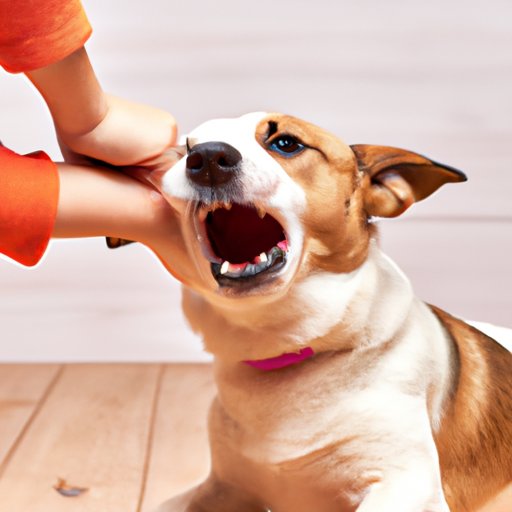
I. Introduction
If you are a dog owner, you know that biting behavior can be a serious problem. Not only can biting lead to injuries, but it can also put your dog at risk of being surrendered or euthanized. For these reasons, it is crucial to address biting behavior in your dog. In this article, we will explore different tips and techniques to stop your dog from biting. We will discuss what causes dogs to bite, how to prevent biting behavior, training techniques, reading dog body language, teaching children how to safely interact with dogs, addressing fear and anxiety, seeking professional help, and being a responsible pet owner.
II. What Causes Dogs to Bite and How to Prevent It
Dogs bite for several reasons – fear, protection, medical issues, or aggression. As a responsible dog owner, it’s essential to prevent biting before it starts. The best way to prevent biting behavior is to socialize your dog from an early age. Encourage your dog to meet different people and animals, and provide positive reinforcement when they behave appropriately. Also, teach bite inhibition. This means teaching your dog to control the force of their bites. Furthermore, a common reason why dogs bite is because they feel uncomfortable or threatened. Recognize the warning signs, such as growling, raised fur, or stiff body language, and remove your dog from the situation.
III. Training Techniques to Stop Your Dog from Biting
Training is a crucial aspect of stopping your dog from biting. Positive reinforcement training is an effective way to address biting behavior. When your dog behaves correctly, provide praise and rewards. Redirecting your dog’s attention is another technique for stopping biting behavior. For instance, offer your dog a toy or a treat instead of chewing on something inappropriate or biting. Additionally, addressing underlying behavioral issues, such as anxiety or fear, can prevent biting behavior from getting worse. Remember that training takes time, so be patient and consistent.
IV. Understanding Dog Body Language to Prevent Bites
Understanding dog body language is vital in preventing biting behavior. When your dog feels threatened or uncomfortable, they will display certain behaviors such as growling, raised fur, or a stiff body posture. Calm your dog by providing a safe and calm environment. Avoid situations that might trigger your dog’s aggressive behavior, and remove them from challenging situations as soon as possible. Understanding your dog’s body language is crucial in preventing bites.
V. Teaching Children How to Safely Interact with Dogs
Teaching children how to safely interact with dogs is crucial in preventing biting incidents. Encourage your child to ask permission before petting a dog, and teach children to avoid approaching unfamiliar dogs. Furthermore, show your child how to recognize when a dog wants to be left alone, and avoid any interaction. Make sure that children understand that dogs are animals and not toys.

VI. Addressing Fear and Anxiety in Your Dog to Prevent Biting
Sometimes dogs bite due to fear or anxiety. Desensitization and counterconditioning are techniques used to train your dog to feel comfortable in situations where they might feel uncomfortable or threatened. Also, sometimes medication is necessary to help manage your dog’s fear or anxiety. Creating a comfortable and safe environment for your dog is also essential in addressing their concerns.
VII. When to Seek Professional Help for Biting Behavior
If your dog’s biting behavior is severe or a result of deep-rooted issues such as aggression, it’s essential to seek professional help. Behaviorists, trainers, and veterinarians can help you understand your dog’s behavior and provide solutions for fixing it. Before seeking professional help, try other techniques such as socializing, positive reinforcement, or addressing underlying behavioral issues.
VIII. Preventing Dog Bites: Best Practices for Responsible Pet Ownership
Being a responsible pet owner goes beyond preventing biting behavior and involves obedience training, dog safety, and being aware of local laws and regulations around dog ownership. Always supervise your dog, keep them on a leash when required, and make sure they get enough exercise and play. Never leave children unattended with dogs, and always make sure to provide adequate training and socialization.
IX. Conclusion
It’s essential to address biting behavior in your dog for your safety, your dog’s health, and the community’s safety. Prevention is key, and it starts with early socialization, bite inhibition, and recognizing warning signs. Training, understanding dog body language, teaching children how to safely interact with dogs, addressing fear, and anxiety, seeking professional help when necessary, and being a responsible pet owner are the keys to preventing dog bites. By following these guidelines, you can keep your dog and community safe and happy.




